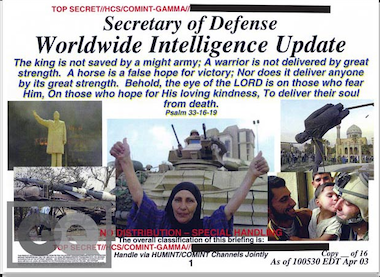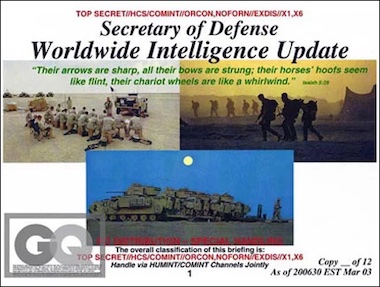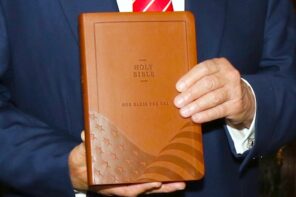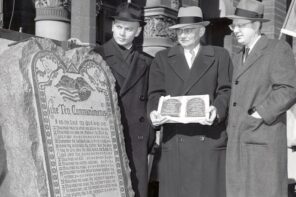UPDATE June 30, 2021: With the “known unknown” of death having taken Donald Rumsfeld, America’s poet laureate of disinformation and destruction, and with the sanitized obituaries already pouring in, we at RD were moved to resurrect a classic from the archives that may, perhaps, be a bit more emblematic of the two-time Defense Secretary’s legacy than the “love” and “integrity” for which he seems to have been heralded among his nearest and dearest. – eds
We, whatever that means now, are more like our enemies than we had imagined. This weekend, GQ magazine posted a series of cover sheets used on classified Department of Defense daily intelligence updates, delivered by Secretary of Defense Donald Rumsfeld to President Bush in March and April 2003.
Collected by journalist Robert Draper, the documents bear an eerie resemblance to the most troubling propaganda of militant Islamists. They mobilize—in fact, manifestly misuse—passages from the Bible alongside images from the invasion of Iraq; and do so at a time “shock and awe” was still a recent enough memory to seem glorious.
In the accompanying article, Draper focuses on the irresponsibility of a defense secretary willing to risk a backlash, which a Pentagon staffer thought “would be as bad as Abu Ghraib,” in order to tickle his president’s piety bone. But there is another story here as well. The images, and the biblical passages chosen to emblazon them with, are especially indicative of a long and concerted campaign by that administration to use the language of Hebrew and Christian scripture to sacralize a modern war of aggression. Moderate Muslim leaders have gone out of their way to repudiate the theology of violent jihad. Yet Christians and Jews have been remarkably complacent about the ways their traditions have provided the spiritual scaffolding for America’s desert crusade.
Some might be tempted to think that such arrogance concerning the favor of God has faded since 2003. As Jeff Sharlet’s recent exposé in Harper’s reveals, it hasn’t. The military plays host to a powerful minority of especially strident Christians, who thrust their beliefs on subordinates entrusted to them with the help of an ever-more conservative chaplaincy corps. General David Petraeus, architect of the “surge” strategy, faced a scandal just last year when he endorsed an evangelical “spiritual handbook for military personnel,” saying it should be “in every rucksack.” The Department of Defense, which still makes discrimination against gays its official policy and war against modern-day Saracens its almost-stated mission, has yet to abandon the theocratic culture that spawned these documents.
A former Air Force intelligence officer told me that the use of biblical verses on cover sheets, in his experience, is “not at all surprising.” Many of those privy to such briefings probably would have been Christian, he suspects, and the rest “knew better than to object.”
Scriptural errancy
Those who want to recover their traditions from conflation with errant militarism can begin by correcting some simple misunderstandings that appear in the leaked documents. It isn’t hard to outdo the Defense Department’s pitiful exegesis. Just open a Bible and look at the verses above and below the ones they quote. If you have to, you can deploy the Beatitudes. The scriptural support for bellicosity quickly withers.
 Take the piece from March 31 [image, left]. There’s an M1 Abrams tank rolling before a desert sunset, with words from chapter 6 of the Epistle to the Ephesians, enjoining hearers to “put on the full armor of God” and “stand your ground.” (Typos aside, most passages are from the New International Version of the Bible, a popular evangelical translation.)
Take the piece from March 31 [image, left]. There’s an M1 Abrams tank rolling before a desert sunset, with words from chapter 6 of the Epistle to the Ephesians, enjoining hearers to “put on the full armor of God” and “stand your ground.” (Typos aside, most passages are from the New International Version of the Bible, a popular evangelical translation.)
But in the verse just before that, it’s perfectly clear that tanks are not the armor being discussed. “Our struggle is not against flesh and blood,” it says, “but against the rulers, against the authorities, against the powers of this dark world and against the spiritual forces of evil in the heavenly realms.” Not a physical battle against one of the world’s poorest countries, apparently, but a spiritual one against the most powerful. Go to the very next verse, and pairing this passage with a tank becomes even more embarrassing. It calls for a “belt of truth,” a “breastplate of righteousness,” and, astonishingly, “the readiness that comes from the gospel of peace.”
The author of Ephesians may have been remembering Isaiah 26:3, which promises, “You will keep in perfect peace him whose mind is steadfast, because he trusts in you.” But, it so happens, the verse just before that appeared on President Bush’s desk on April 8, above a picture of tanks passing under the Hands of Victory monument in Baghdad: “Open the gates that the righteous nation may enter/The nation that keeps faith.” What was that about perfect peace? Which nation is supposed to be righteous?
 Then, two days later, an image of Saddam Hussein’s statue being pulled down appeared alongside words from Psalm 33 [image, right]: “The king is not saved by a might [sic] army; A warrior is not delivered by great strength.” Once again, the passage defeats its usage. One would hardly mistake the Iraqi forces for the stronger, mightier side. Instead, the psalm assures that all the military force in the world cannot equal the power of hope in God’s love.
Then, two days later, an image of Saddam Hussein’s statue being pulled down appeared alongside words from Psalm 33 [image, right]: “The king is not saved by a might [sic] army; A warrior is not delivered by great strength.” Once again, the passage defeats its usage. One would hardly mistake the Iraqi forces for the stronger, mightier side. Instead, the psalm assures that all the military force in the world cannot equal the power of hope in God’s love.
One more. On March 20, Rummy called upon Isaiah 5:28 together with images of Bradley vehicles and worshipping warriors [image, below]. There are certainly the rudiments of warmongering in that verse: arrows, bows, horses, and chariots all fiercely at the ready. But wait. Whose weapons are these? The chosen ones of the LORD, perhaps? Sorry. If the DoD’s resident experts had bothered to look a few verses earlier, they’d see that the army is that of “distant nations,” “those at the ends of the earth.” They are called by “the LORD’s anger,” which “burns against his people.” So, either America represents this fierce army, which would make the Iraqis God’s chosen, or America is God’s chosen and Iraq is the nation that has been risen against us by God for our iniquities. Neither is very inspiring.
 It is an instructive irony that a closer look at these passages so tangles up hero from enemy, crusader with militant jihadi. Jewish, Christian, and Muslim forms of religious violence eagerly drum up proof-texts without regard for longstanding traditions of interpretation, to say nothing of immediate context. For those who want to defend these traditions from the incursion of militarism, it doesn’t take much. Yet too few on our side of the supposed “clash of civilizations” have let themselves be bothered to try.
It is an instructive irony that a closer look at these passages so tangles up hero from enemy, crusader with militant jihadi. Jewish, Christian, and Muslim forms of religious violence eagerly drum up proof-texts without regard for longstanding traditions of interpretation, to say nothing of immediate context. For those who want to defend these traditions from the incursion of militarism, it doesn’t take much. Yet too few on our side of the supposed “clash of civilizations” have let themselves be bothered to try.
Enemy in the mirror
These pieces of official iconography—at once digital folk art and presidential artifacts—lay bare that as early as 2003 the self-image of American war-makers at the highest levels had become hardly distinguishable from the enemy’s most populist propaganda. Terrorist creations collected by West Point’s Islamic Imagery Project differ only in that they were broadcasted rather than classified.
One pastiche shows Osama bin Laden hovering over a young warrior holding an assault rifle, inscribed in Arabic with a saying of the Prophet Muhammad, that “there will be a Caliphate in the way of prophethood.” The implication, of course, is that bin Laden is the legitimate inheritor of the prophet’s mantle—a claim that the more than 90% of Muslims around the world who refuse to condone the 9/11 attacks would take offense at. Another portrays a fighter in a gas mask along with the Qur’anic formula (Qur’anic except for the last word), “In the name of God, the Beneficent, the Merciful/Peace and blessing be upon the leader of the mujahideen.” Over his left eye, a saber and an M16 rifle cross as if to claim the modern conflict and the campaigns of Muhammad’s time as a single struggle.
 Most haunting of all in the West Point collection are the martyr portraits, photos ritually taken just before the subject embarks on a suicide mission. In one hand, he holds a gun, and in the other, a Qur’an. Pious passages are in the background. Though the tragedy in these images can hardly abide comparison, the March 17 intelligence update (presented to the president on the day he issued his ultimatum to Iraq) had on its cover [image, left] a pair of American soldiers bent in prayer over their rifles, with a passage from Isaiah 6: “Whom shall I send, and who will go for us? Here I am, Lord, send me.” It should go without saying that Isaiah was being called as a prophet of peace, not as a soldier.
Most haunting of all in the West Point collection are the martyr portraits, photos ritually taken just before the subject embarks on a suicide mission. In one hand, he holds a gun, and in the other, a Qur’an. Pious passages are in the background. Though the tragedy in these images can hardly abide comparison, the March 17 intelligence update (presented to the president on the day he issued his ultimatum to Iraq) had on its cover [image, left] a pair of American soldiers bent in prayer over their rifles, with a passage from Isaiah 6: “Whom shall I send, and who will go for us? Here I am, Lord, send me.” It should go without saying that Isaiah was being called as a prophet of peace, not as a soldier.
Both the cover sheets and the Islamist pictures depict 21st-century war crossing paths with ancient religion. But in each case, the two don’t have to mix (and actually don’t mix) in the way their creators want them to. The warfare and the scripture seem to be at odds. Like all interpretation, it is a choice, an expression of a common desire to wash the most temporal, brutal, sacrificial violence in the water of eternity. But in these religions, there remains the choice to do differently. We can also choose to hear out the call for peace that runs so strongly through them, despite the efforts of some to do the opposite.
The visual effect of these cruel scenes contains a flash of recognition that momentarily obscures their cruelty. Against the intentions of the artists, this recognition repudiates the illusion of difference between us and them that denies the humanity of the other and makes every senseless conflict possible. Both sets of images share a common hope for divine redemption and peace in our time, as well as a trust in the marvel of violence to bring them about.
These common, perverse dreams, both equally doomed, offer an inkling of hope that there is enough common ground between the apex of American power and the popular expressions of its terrorist enemies that the two might someday graze together, like Isaiah’s wolves and lambs. It is, backhandedly, the sign that a more patient dialogue, over years of inevitable sacrifice and setback on all sides, might finally be fruitful, uncovering a world everyone can stand to live in.
But a first step is for believers to denounce these images with such a prophetic, steadfast sound that their faiths can never be marshaled in the service of aggression again.





